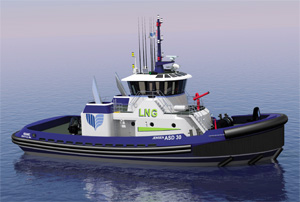Earlier this year, the world’s first liquefied natural gas-powered tugboat sailed from an Istanbul shipyard to a Statoil terminal near the Norway gas fields. While en route, the twin engine Borgoy stopped in Zeebrugge, Belgium, where port officials made special arrangements to fuel the vessel.
“The LNG fueling operation was executed ‘Truck to Ship,’” port officials said in a news release marking the occasion in which an LNG-filled trailer positioned on the quay was used to fuel the tug.
The refueling operation was a milestone for the port, which is among the busiest in Europe. But the operation also highlighted the lack of permanent LNG fueling terminals in the world’s largest ports. In the United States, this type of LNG infrastructure does not exist in most ports.
However, that’s starting to change, driven by new LNG investments from energy companies and more orders from vessel operators.
“I think if you look at each of the regions and where demand is beginning to pop up, LNG-consuming marine vessels are finding that multiple players are vying to provide them with fuel,” said John Hatley, Americas vice president for ship power for Wärtsilä North America.
There are clear benefits to LNG-powered tugboats. It burns cleaner than diesel, releasing less carbon dioxide, nitrogen and sulfur than diesel — critical benefits as U.S. emissions regulations tighten in 2015 and 2016. LNG also costs less than diesel.
There are challenges to adoption as well, including higher build costs compared to a similar diesel-powered vessel. LNG vessels also need larger fuel tanks than a comparable diesel tug, which reduces space.
Harbor tugs that return to a home port most nights are viewed as a likely starting point for LNG-powered tugs. Vessels that operate on set routes or travel on a single river or waterway also are prime candidates for LNG due to fewer fueling variables.
Jensen Maritime Consultants of Seattle has already designed a line of LNG-powered escort tugs that offer 14-day endurance capability for harbor and escort work. The company has received several orders for the vessel, although it declined to name its clients. When they might enter service, however, is not certain.
“Our clients are battling high capital costs for the equipment and availability of LNG at the docks,” said Jensen Vice President Johan Sperling.
Within the past year there has been steady progress on the road to a reliable LNG supply. In the Port of Jacksonville, Fla., for instance, Clean Energy Fuels Corp. has teamed up with General Electric and Ferus Natural Gas Fuels to build what would be the first marine LNG terminal in the United States, Bloomberg News reported.
LNG America of Houston is developing fueling facilities in large Gulf of Mexico ports that are expected to come on line in late 2015 or early 2016 for tugs, workboats, OSVs and other vessels.
The company contracted Jensen Maritime to design and build bunkering barges capable of holding 3,000 cubic meters of LNG. The bunkering barges would be the first of their kind operating in the Gulf.
“It’s sort of the last big piece of the puzzle,” said Keith Meyer, LNG America’s CEO. “The availability of LNG supply is the main factor in the decision whether to switch to LNG as a fuel.”
“I believe that what you have are two very large industries coming together,” he added. “One is the natural gas industry; the other is the marine industry. Both sides have to take steps to meet somewhere in the middle.”
Meanwhile, Royal Dutch Shell recently announced plans to “pause” development of gas liquefaction units planned in the United States and in Canada — at the company’s Geismar Chemicals facility in Geismar, La., and at the Sarnia Manufacturing Centre west of Toronto.
“The pause will allow the review of LNG for transport opportunities in North America in order to ensure a flexible and competitive portfolio,” Shell spokeswoman Destin Singleton said in an e-mail. “We continue to adapt to the growing demand from sectors like marine and on-road while evaluating the most promising locations.”
A closer read of the Royal Dutch Shell announcement suggests the company is reconsidering possible locations for LNG, not its overall commitment to the fuel, Hatley said.
Despite these advances, the LNG market is still years away from maturity. For one thing, investments like the ones planned in Jacksonville and elsewhere take time to be designed and built. The Jacksonville facility, for instance, is projected to supply up to 300,000 gallons of LNG a day by 2016, according to the Bloomberg report.
Another factor: Many of the LNG-powered containerships and other large fuel customers needed to support LNG infrastructure are in many cases at least a year away from completion.
“We are definitely much closer to having a supply solution, though most companies would probably still say that we have a ways to go,” Sperling said.
“Another milestone will be the establishment of infrastructure in and around the ports to store and handle LNG.”

